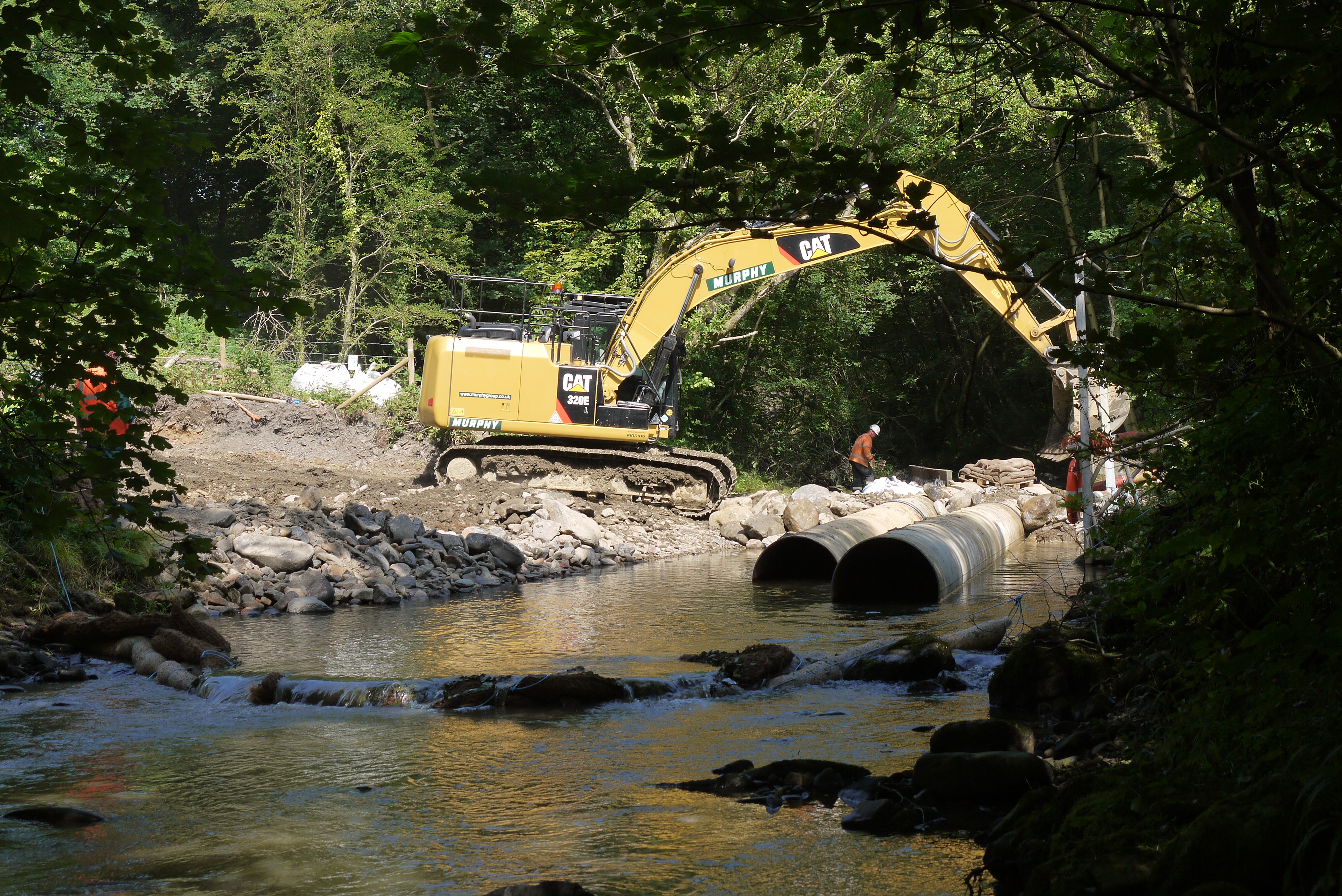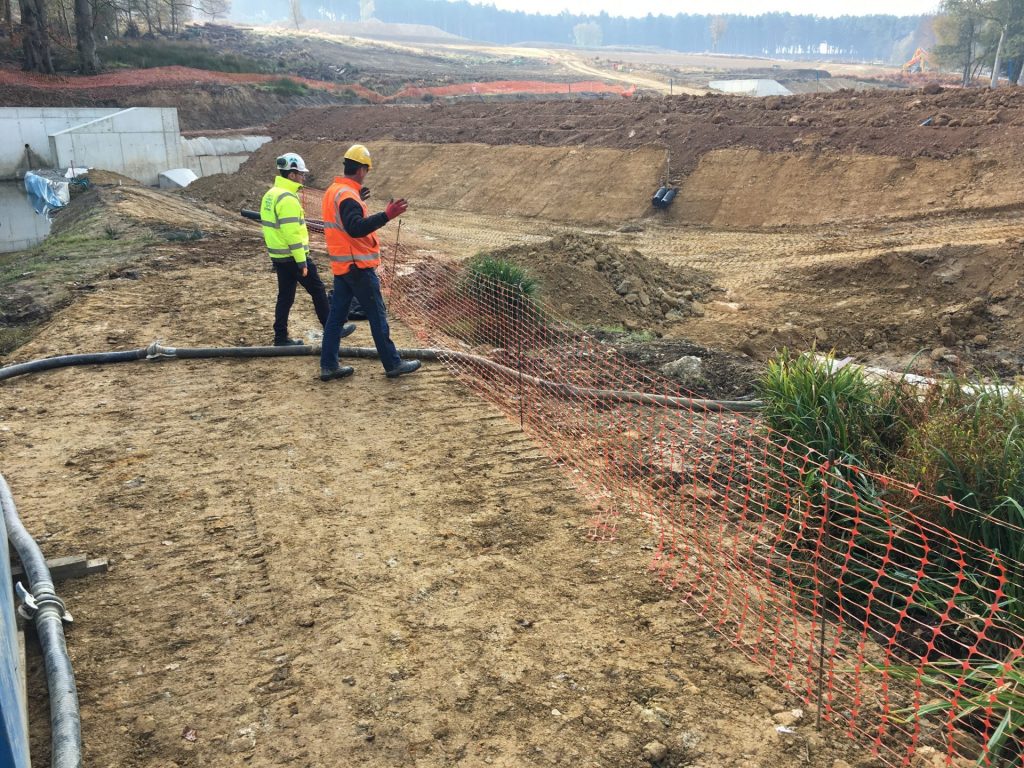Before starting your project, sediment and silt management is an essential part of your planning. Silt, soils, mud, clay, and sand are the primary pollutants generated at construction sites, mainly due to erosion of exposed soils by surface water runoff leading to siltation of water courses.
Effective surface water management during construction is crucial to prevent sediment pollution and siltation, it will minimise the risk of prosecution, which can lead to significant financial penalties and reputational damage. Having a Surface Water Management Plan in place is important, however you must understand the physical properties of your site to be effective.
The adoption of a surface water plan including appropriate erosion and silt controls provides many benefits, including excess siltation on site:
- reduce downtime costs and risk of delays to construction works from poor or wet ground conditions
- save space and land acquisition costs by reducing reliance on settlement ponds
- improve relationships with the client, regulator and neighbours
- reduce complaints, disputes and the potential for compensation claims
- enable quicker, cheaper and better land reinstatement
- maintain and improve reputation within the industry
Sediments can be mobilised from a number areas on site:
- roads and drainage ditches
- excavations and dewatering areas
- wheel washing facilities
- surface soil stripping
- river crossings
- material storage areas and stockpiles
We have decades of experience in advising clients on managing silt and sediment, and industry-leading products to help avoid risks of polluting. Contact our Technical Team for a no-obligation discussion, if you need help with site planning or remediation.
Why control siltation? Ensuring environmental safety on construction sites
Good surface water management is essential for the protection of sensitive environmental receptors such as aquatic life in rivers, streams and lakes. Groundwaters, drinking water aquifers, abstractions industrial and domestic processes as well as wastewater treatment facilities also require protection.
Sediment pollution can cause significant damage that may result in criminal prosecution, prison sentences and fines of up to £3 million.
Monitoring is an essential part of preventing silt pollution. You can find out more about this in our article on monitoring water during construction.


What is siltation?
Siltation refers to the process by which water bodies become polluted with fine particulate matter, mostly silt and clay. This occurs when soil erosion or sediment spills introduce fine particles into ditches, rivers, lakes, and other water bodies.
How can silt reach receptors?
Once sediments are mobilised they will travel the path of least resistance, often resulting in silty water escaping site. Key pathways include:
- bore holes
- land drains
- ditches and streams
- overland flow
- surface water and foul drains
Common sources of silt pollution on construction sites
Why is silt-laden water run-off a significant issue in the construction industry?
Silt-laden water run-off is a major cause of water pollution from the construction and demolition industry in England and Wales, accounting for around 40% of the industry’s damaging water pollution incidents.
This type of pollution can deoxygenate water, block the gills of fish, and smother aquatic plants and invertebrates, leading to severe environmental damage and potential legal consequences.
What legal implications can arise from silt pollution on construction sites?
Pollution of a watercourse, including silt pollution, is an offence and can result in significant fines.
How does construction activity contribute to silt pollution?
Construction activities contribute to silt pollution by stripping topsoil and removing vegetative cover, which are natural defences against erosion. Heavy machinery compacts the soil, increasing run-off rates and the scouring effect. Operating machinery in wet conditions churns up the ground, releasing soil particles that become suspended in surface water. If this water flows into a watercourse, it can cause siltation and significant environmental harm.
What are the main principles of siltation control?
Controlling a pollution event at source i.e. preventing it from happening in the first place will nearly always be less expensive than managing a pollution event.
A comprehensive understanding of site drainage is a key element in planning how to prevent clean water from entering a site and how to manage silty water produced on site. Conducting site assessments to identify areas vulnerable to erosion is also a sensible part of planning.
It is best practice to retain vegetation cover, minimise soil stripping (preventing siltation), and establish new vegetation on bare ground at the earliest opportunity. Erosion of soils can be caused by wind but is normally attributed to rainfall. Sheet flows cause slips, gulleys, and rills to form whilst drainage channels can give rise to scouring of the bed and banks, all factors that can increase the mobilisation of material.
Identifying key areas on site that require protection is another important aspect of planning, these include:
- haul roads and site compounds
- entrances to drains
- at river crossings
- in drainage channels
- in lagoons
- on slopes
Settlement units and lagoons are commonly used for treating muddy water on site but they often can’t treat the smallest sediment particles. Boosting the treatment power of lagoons using Gel Flocculant anionic flocculants, Silt Net, Treated Geo-Jute or Pipe Reactor can be a key consideration, especially when managing the downstream impact of clayey soils.
It is also possible to work effectively on linear construction sites such as railway lines, which are notoriously tricky.
Planning silt control interventions is relatively quick and painless. Slowing the flow of silty water naturally aids deposition, where sediment can be trapped and removed whilst allowing water time to infiltrate. Frog Environmental provide a range of products that are inexpensive and simple to deploy, all designed to help our clients control silt on site:
- Silt Mat™ – captures sediment and prevents resuspension
- Silt Wattle – reduces flow on sloping ground and in channels & ditches
- Floc Mat® – traps sediment and cleans muddy water using a non-hazardous flocculant
- Silt Net – for placement in lagoons to aid sediment deposition
- Treated Geo-Jute – for polishing water and lining channels
- Rock Check – reduces and distributes water flow in channels
- Gel Flocculant – a low maintenance and non-toxic flocculant used to support silt and water separation to clean muddy water
- Pipe Reactor – mobile water treatment unit
- Bubble Curtains / Bubble Barriers – highly effective at aerating the entire water column and reducing movement of silt in water.
What are the potential consequences of inadequate silt management on construction sites?
Inadequate silt management can lead to several negative consequences, including:
- Environmental damage and legal prosecution.
- Financial costs due to fines and remediation efforts.
- Lost time and inconvenience due to poor ground conditions halting construction work.
- Damaged reputation and potential harm to third-party clients’ images.
- Increased risk of litigation from poorly designed water diversion schemes affecting landowners’ water resources.
By proactively addressing silt management, construction companies can reduce their vulnerability to pollution incidents, environmental damage, and legal repercussions.
We offer free training on the risks of silt on a construction site and you can download our Silt Control Toolbox Talk to communicate key points to your team. We can also help you understand why your soil structure and particle size is important and offer support around mitigations when looking at SWMPs.
Bringing our water quality and silt control specialist team of consultants on board early allows you to prevent issues arising; through training up your staff, offering technical design and site preparation support, as well as products that are engineered to meet needs across a wide range of industries.
We offer a non-obligatory call or Teams meeting with our Technical Team to talk through your needs at any stage of your project to see where we or our environmentally-friendly product solutions may help.
For products, services, training and technical sales support contact us or call 0345 057 4040.
